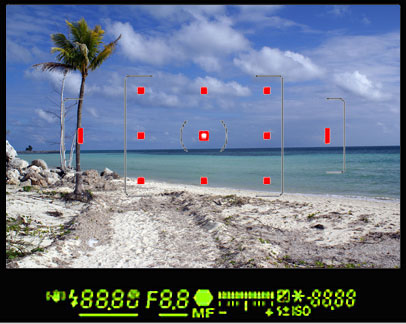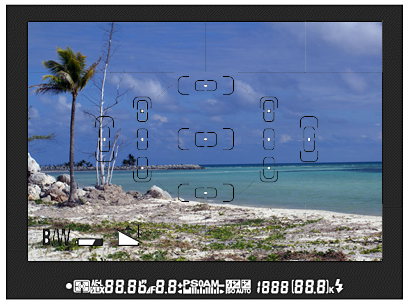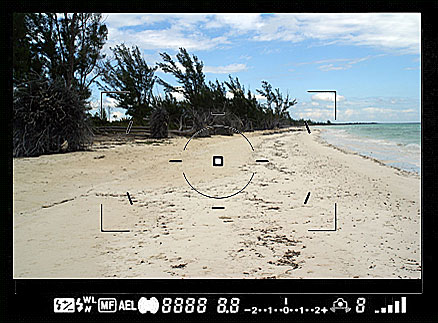10 Megapixel SLRs Compared
In items as complex as a camera, different buyers find different features important to their needs. For that reason we will attempt to look at areas that are typically important to some buyers and compare the four cameras in that area.

Pentax K10D
VIEWFINDER: The Pentax has the best viewfinder, followed closely by the Nikon D80, then the Sony A100. The Sony viewfinder is remarkable for a penta-mirror setup, but it is no match for the true pentaprisms in the Nikon and Pentax. The Canon is by far the worst of the lot in viewfinders. Best in this case is measured by brightness of the screen image, ease of seeing the entire screen, and "natural perspective". If you want to see a mediocre viewfinder for comparison take a look at the Olympus E500 which makes the user feel like they are looking down a tunnel.

Canon Rebel XTi
VIEWFINDEER FEATURES: All of the 10 megapixel SLRs have adjustable diopters for dialing in a mild correction for shooting without glasses. The Pentax is the only camera in the group to also offer interchangeable focusing screens.
POWER OPTIONS: The Pentax K10D, Nikon D80, and Canon XTi all offer optional battery grips for providing more power and options for vertical shooting. The Sony A100 does not offer this feature. All four models use proprietary Lithium-Ion batteries that can provide 800 exposures or more before recharge, and the battery charger is included in the retail package. Canon reduced the size and capacity of the XTi battery, which may affect the number of shots between charges compared to the 8 megapixel XT model. The Sony A100 uses a new battery type that is not interchangeable with earlier Maxxum digital camera batteries. Oddly enough, the Pentax K10D turns out to use the same NP400 battery that powered the last Minolta Digital SLRs like the Maxxum 5D, so your spare Maxxum batteries will work in the new Pentax K10D. The Nikon D80 remains a proprietary design that refines and extends the capabilities of batteries used in the D70 and D70s.
ANTI-SHAKE: Minolta pioneered anti-shake built into the camera body, which allowed shooting at slower shutter speeds with any lens attached to the camera. Sony refined and improved the feature. Pentax also has added an anti-shake program that is even more sophisticated than the one used by Sony. Both Canon and Nikon have special lenses with anti-shake motors, but they are very expensive, and anti-shake only works with those lenses.
COMPATABILITY: Nikon and Canon are the brands that most often come to mind when you think of professional photography. They both have large lens lines that work on their cameras. The new Sony uses the Minolta Maxxum lens mount and can mount and work with almost any of the 18 million Maxxum mount lenses sold in the last 20+ years. The Pentax K10D has full functionality with any autofocus K-mount lens, and these lenses have been manufactured for many years. In addition Pentax has special focus assist for ANY Pentax K-mount lens ever produced - which now total about 25 million lenses. You can even use older screw-mount Pentax lenses in manual mode with a screw-to-K-mount adapter

Nikon D80
AUTOFOCUS: All cameras were compared using a 50f1.4 lens, since the shallow depth of field evened the focusing playing field for all cameras. All four 10 megapixel cameras were very fast in focusing and locking on the same subjects - much better than older models like the Pentax *ist D or the original 6 megapixel Canon Digital Rebel. Focusing noise was lowest for the Canon, but it was only very slightly quieter than the Nikon D80 (with a 50f1.4D) and Pentax K10D (50f1.4 FA) which were virtually tied. The Sony was just as fast in focusing, but noisier than the other cameras with a Minolta 50f1.4 lens. Perhaps the Sony would be quieter with the reworked Sony 50f1.4 if anyone could find it and they are willing to pay the new $350 cost Sony is asking. However, this was as fair as we could make it with the 50f1.4 lenses we had available.

Sony A100
FOCUS MODULE: All four 10 megapixel SLRs use some of the most capable focusing modules available from each manufacturer. There are, however, some differences in technical specifications and functionality. The Pentax K10D uses an 11-point focusing system, Nikon also uses an 11 point focusing array with a layout similar to the Pentax K10D, Sony uses an 8-point array, and Canon uses their 9 point focus array that is apparently borrowed from the 30D. The number of points is only part of the story, however, since most manufacturers use the more sensitive cross array for the center point only. The Cross point is sensitive to both vertical and horizontal detail where the single point is sensitive to just one direction. Pentax says they use 9 cross points in their focusing module.
In items as complex as a camera, different buyers find different features important to their needs. For that reason we will attempt to look at areas that are typically important to some buyers and compare the four cameras in that area.

Pentax K10D
VIEWFINDER: The Pentax has the best viewfinder, followed closely by the Nikon D80, then the Sony A100. The Sony viewfinder is remarkable for a penta-mirror setup, but it is no match for the true pentaprisms in the Nikon and Pentax. The Canon is by far the worst of the lot in viewfinders. Best in this case is measured by brightness of the screen image, ease of seeing the entire screen, and "natural perspective". If you want to see a mediocre viewfinder for comparison take a look at the Olympus E500 which makes the user feel like they are looking down a tunnel.

Canon Rebel XTi
VIEWFINDEER FEATURES: All of the 10 megapixel SLRs have adjustable diopters for dialing in a mild correction for shooting without glasses. The Pentax is the only camera in the group to also offer interchangeable focusing screens.
POWER OPTIONS: The Pentax K10D, Nikon D80, and Canon XTi all offer optional battery grips for providing more power and options for vertical shooting. The Sony A100 does not offer this feature. All four models use proprietary Lithium-Ion batteries that can provide 800 exposures or more before recharge, and the battery charger is included in the retail package. Canon reduced the size and capacity of the XTi battery, which may affect the number of shots between charges compared to the 8 megapixel XT model. The Sony A100 uses a new battery type that is not interchangeable with earlier Maxxum digital camera batteries. Oddly enough, the Pentax K10D turns out to use the same NP400 battery that powered the last Minolta Digital SLRs like the Maxxum 5D, so your spare Maxxum batteries will work in the new Pentax K10D. The Nikon D80 remains a proprietary design that refines and extends the capabilities of batteries used in the D70 and D70s.
ANTI-SHAKE: Minolta pioneered anti-shake built into the camera body, which allowed shooting at slower shutter speeds with any lens attached to the camera. Sony refined and improved the feature. Pentax also has added an anti-shake program that is even more sophisticated than the one used by Sony. Both Canon and Nikon have special lenses with anti-shake motors, but they are very expensive, and anti-shake only works with those lenses.
COMPATABILITY: Nikon and Canon are the brands that most often come to mind when you think of professional photography. They both have large lens lines that work on their cameras. The new Sony uses the Minolta Maxxum lens mount and can mount and work with almost any of the 18 million Maxxum mount lenses sold in the last 20+ years. The Pentax K10D has full functionality with any autofocus K-mount lens, and these lenses have been manufactured for many years. In addition Pentax has special focus assist for ANY Pentax K-mount lens ever produced - which now total about 25 million lenses. You can even use older screw-mount Pentax lenses in manual mode with a screw-to-K-mount adapter

Nikon D80
AUTOFOCUS: All cameras were compared using a 50f1.4 lens, since the shallow depth of field evened the focusing playing field for all cameras. All four 10 megapixel cameras were very fast in focusing and locking on the same subjects - much better than older models like the Pentax *ist D or the original 6 megapixel Canon Digital Rebel. Focusing noise was lowest for the Canon, but it was only very slightly quieter than the Nikon D80 (with a 50f1.4D) and Pentax K10D (50f1.4 FA) which were virtually tied. The Sony was just as fast in focusing, but noisier than the other cameras with a Minolta 50f1.4 lens. Perhaps the Sony would be quieter with the reworked Sony 50f1.4 if anyone could find it and they are willing to pay the new $350 cost Sony is asking. However, this was as fair as we could make it with the 50f1.4 lenses we had available.

Sony A100
FOCUS MODULE: All four 10 megapixel SLRs use some of the most capable focusing modules available from each manufacturer. There are, however, some differences in technical specifications and functionality. The Pentax K10D uses an 11-point focusing system, Nikon also uses an 11 point focusing array with a layout similar to the Pentax K10D, Sony uses an 8-point array, and Canon uses their 9 point focus array that is apparently borrowed from the 30D. The number of points is only part of the story, however, since most manufacturers use the more sensitive cross array for the center point only. The Cross point is sensitive to both vertical and horizontal detail where the single point is sensitive to just one direction. Pentax says they use 9 cross points in their focusing module.










89 Comments
View All Comments
IronChefMoto - Tuesday, December 26, 2006 - link
Here's my 2 cents -- the poster who called Wesley's article "sad" is sort of right. If you want the most comprehensive reviews of digital cameras, those and other websites are the place to go.Does it mean that Fink's article is "sad?" No -- he probably put some decent work into it. Give the guy a break. I did detect a hint of Pentax love in the piece, but whatever. I'm a Canon convert from Nikon of late, so I'd probably lean Canon if I were writing it. Do I agree with that sort of slant? Absolutely not, but we're not writing the articles, are we?
Honestly -- if you're coming to Anandtech for photography hardware reviews, you need to buy a handheld point and shoot. Otherwise, you're going to get a 5 page review on 4-5 cameras and come away with...a Pentax recommendation (niche product?) with props to a great rebate on the camera (???). That said...
...if you're serious about trying a dSLR, and my Rebel XT is my first, ask someone who already shoots with one, if you're uncomfortable reading the other website reviews (complicated and such). I knew enough to read the articles (with some photography background and instruction) AND ask questions of owners. But you ALWAYS ask questions of owners who know what they're doing with their hardware. If they shoot professionally, they can be a really great resource.
Most folks I asked pointed me to one thing -- lenses. You buy a body as an accessory to lenses that you already own. If you don't have any lenses, then you start from scratch, and the buying process is much more involved. The body may have features this or features that, but all the image stabilization and doodads on the body aren't going to help the operator (a) compose and (b) shoot a better picture. The glass will help paired with good skill.
Read fred-miranda.com (???) for reviews of good lenses by real users. Pick one out that may meet your day-to-day use needs. I selected a pricey Tamron 2.8 28-75mm lens that does well in a lot of lighting/portrait situations, and I couldn't be happier with it. I spent about $200 more than the kit total from B&H, but I also have a lens that I can move to a new body later on.
Finally -- DO NOT BUY FROM THE CHEAPEST SHOP YOU FIND ONLINE! There's a website out there where visitors post photos of the addresses for the Brooklyn and NYC scam shops that sell grey market camera equipment. I can't remember the address, but it's scary -- Russian mafia scary. Think abandoned warehouse from Robocop scary. B&H is your best bet for getting quality service and reasonable pricing. Can you save going other places? Yeah. Can you get your CC # and home address back from the Russian mob after you get your grey market camera? Probably not...
Justin Case - Wednesday, December 27, 2006 - link
Yes, I completely forgot to mention Fred Miranda's site. Not as thorough as the others, but lots of different opinions, which is always good (also because it gives an idea of how good the quality control of each manufacturer is).I was a Nikon user for a long time, then I sold my gear and switched to Canon when I went digital. I missed Nikon's wide-angle lenses, but Canon's teles and amazing IS made up for it. Now Nikon has pretty much caught up in terms of image quality (they still don't have any 35mm sensors, though), and Canon also have a couple of good wide lenses (the EF-S 18-55 2.8 IS is amazing, shame it's not an EF). If I was going to start from scratch today I'd probably go for a Nikon D200. All things considered, I think it's the best value for money, at least until Canon releases a successor to the 30D.
Justin Case - Tuesday, December 26, 2006 - link
If you want to read about cameras, check out DPReview, Steve's Digicams, Imaging Resource, etc.. This article is just sad. It seems that it was written by someone with 6 months' experience in photography and basic "Google skillz".http://dpreview.com/">http://dpreview.com/
http://www.luminous-landscape.com/">http://www.luminous-landscape.com/
http://www.steves-digicams.com/">http://www.steves-digicams.com/
http://www.imaging-resource.com/">http://www.imaging-resource.com/
etc.
Frumious1 - Tuesday, December 26, 2006 - link
If you want to just come and post hate and tell people to look elsewhere, please just STFU. Your post is just inflammatory. It seems like it was written by someone with 6 minutes of skimming the article and basic "Asshole skillz".We all know there are other sites that do digital camera reviews. They often go way overboard on features table and jargon use without just giving the basic information of "why is this particular camera better?" As a quick introduction and BUYER'S GUIDE this gives people a lot of good information. I own a Canon Digital Rebel, and it works fine for me, but I'm sure it is far inferior to the latest models and I frequently think about upgrading.
What I got from this review: Canon and Nikon seem to be resting on their laurels quite a bit, and no doubt they will still sell a crapton of cameras. Bigger doesn't mean better, though - unless you think Dell makes the best PCs? Personally, I'm glad to see people like Pentax challenging the big players with features that are truly useful (builtin stabilization rather than expensive in-lens solutions). That doesn't mean I'm going to buy a Pentax right now, but maybe Canon will finally get off their asses and make something a bit more revolutionary than just a quick regurgitation of last year's model with a higher MP sensor and a few other tweaks.
Justin Case - Wednesday, December 27, 2006 - link
Canon and Nikon are light years ahead of the competition, as anyone who really understands photography can tell you. Even the original Digital Rebel will wipe the floor with anything Pentax has to offer, simply because it has better colour rendition, better SNR, and (above all) a much, much better lens line-up (which is the whole point of SLRs).8 MP are more than enough to print at any normal size; beyond 6 MP or so, what matters in a sensor is its physical size. Cramming more pixels into the same space only produces noisier images. A bigger sensor with the same number of pixels will have less noise, and therefore produce better images, especially in low light situations. Not to mention give you more room to play with DOF.
Built-in image stabilisation will never come close to Nikon's VR, let alone Canon's IS (which is in a league of its own). Not unless they start making the cameras much bigger, to acommodate complex optical stabilisation systems. Anyone with a bit of experience with professional equipment knows this. Good optical image stabilisation takes up space.
Your complaints about dedicated camera sites "going overboard with features and jargon" could make some sense if this was a review of pocket digicams (then again, you'll find that the sites I listed above have perfectly accessible reviews of pocket digicams, too). But it is not. This is an article about SLRs. Someone who doesn't know anything about cameras shouldn't even be consideirng an SLR - it's more expensive, it's heavier, and it's harder to use. A dummies' guide to SLRs is like a beginner's course for supersonic fighter pilots. They don't put you in one (and you shouldn't want to be put in one) unless you've had a lot of experience flying simpler, safer aircraft, and understand the concepts involved.
If you have some experience with compact digicams and are considering an SLR, then what you need to read is an article about photography (Dan Rutter has a couple of good ones on dansdata.com, as do the sites I listed above), not a (clueless) review of different models, that seems based on the spec sheets instead of any real experience. And once you do understand how SLRs work, go read a review written by an experienced photographer (or two, or three).
When I want to read about computers, I go to an IT site. When I want to read about photography, especially professional and semi-professional equipment (which is what SLRs are) I go to a site run by photographers. But hey, maybe I've been doing it the wrong way around. I can't wait for the new article on database servers from Luminous Landscape...!
appu - Wednesday, December 27, 2006 - link
I agree with Justin. I respect Anandtech and have been a regular reader for 5+ years now. I will give credit to Wesley for taking the effort to summarize what's at best a very difficult market but I don't agree with the conclusions he's drawn. Price and in-camera stabilization alone do not make a particular SLR better than another. I tend to think Wesley *knows* his cameras and photography and that this article is probably an effort to make a review more appealing to the IT-centric minds of AT readers. However, I will say that a buying guide for cameras should be decided on different criteria, and much as I appreciate Wesley and AT for making this effort, I'd rather they do not. They would just be doing themselves a great injustice.Unfortunately for cameras in general and SLRs in particular, digital has made them commodities just like IT components. There was a time when camera bodies really were an investment. Digital SLR bodies however are like computer peripherals - obsolete by the time you decide to get the model you like. The newer ones are always better and are released so soon (upgrade cycles of 12/18/24 months on consumer/prosumer/pro lines) that all the money you spend on your camera body isn't going to get you anything in return when you upgrade. In that sense, an AT review to identify "value" among camera bodies makes sense, because for the average amateur or hobby photographer, it makes more sense going for a slightly less sturdy (but nevertheless rich-featured) camera body and put the hard-earned cash down for some good lenses, because it's the lenses that really make a camera body sing (or draw, whatever) after all. So I'd like AT to - if they continue reviewing digital SLRs, that is - focus (please excuse the pun) on this angle and make it explicit that it's this angle they are focusing on.
What I'm saying is that their articles should probably state at the outset that they're targeted at the casual amateur photographer who is looking for a lot more flexibility over what's offered by pocket-sized digital cameras. The serious photographers (read: those who want to make it a profession or dedicated hobbyists) can obviously go elsewhere.
vailr - Tuesday, December 26, 2006 - link
Did you overlook Fuji D-SLR's?Example: FUJI FILM FinePix S9100 9.0 MP Digital SLR $444.89
http://www.abesofmaine.com/viewproduct.asp?id=fjfp...">http://www.abesofmaine.com/viewproduct.asp?id=fjfp...
Wesley Fink - Tuesday, December 26, 2006 - link
The Fuji does not have the ability to change lenses, it uses a viwfinder like move cameras rather than true optical viewfinder,like you find in SLRs in this guide. It uses a much smaller sensor such as you will find in point and shoot cameras instead of the APS C size or larger sensors found in SLR cameras. It is "SLR-like" but not an SLR. It is a fine camera for what it is, but it is not in the same category as the cameras metioned in this guide.Fuji does make a specialized digital SLR, the S3 and recently announced S5, that use Nikon lenses. Prices have recently dropped on the S3, but it has sold in the $2000 price range and is a favorite of some wedding photographers.
AxemanFU - Tuesday, December 26, 2006 - link
I had to take exception to this. Nikon has never made one of their budget scale downs better than the predecessor, though they do sometimes make them almost as good. The D40 lacks an integral autofocus motor, so it relies on the AF lenses to have their own autofocus, and most lenses still don't have that integrated. This means it is somewhat useless for your older Nikon AF lenses unless you enjoy manual focus. The D50 optics and autofocus are also virtually identical to that of the D70, while the D40's are substantially less sophisticated. The D50 is a significantly more capable camera over all, though the D40 is a nice camera in it's own right. New buyers getting new lens kits can go with a D40 and be happy, but anyone that has invested in Nikon lenses previously would be wasting thier money most likely.ElFenix - Thursday, December 28, 2006 - link
well, not really, unless they are the AF-S models, as the lack of in-body autofocus motor makes all the other nikon lens into manual focus, iirc. better to get the D50.